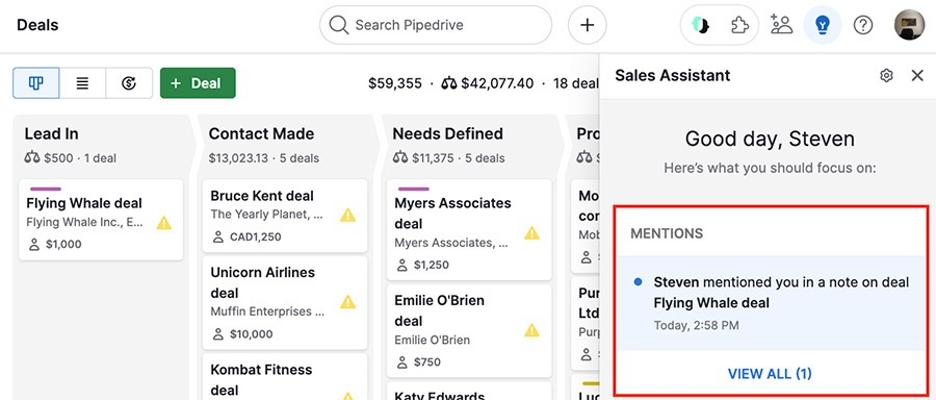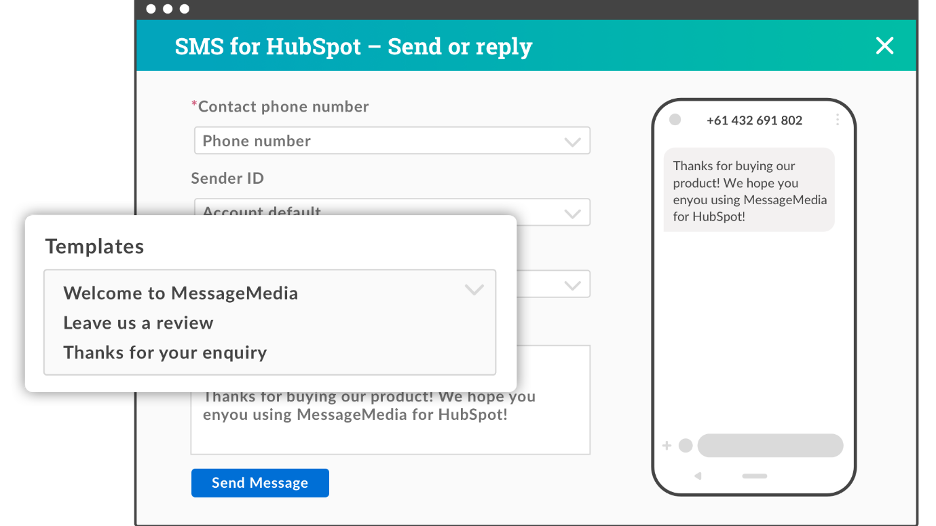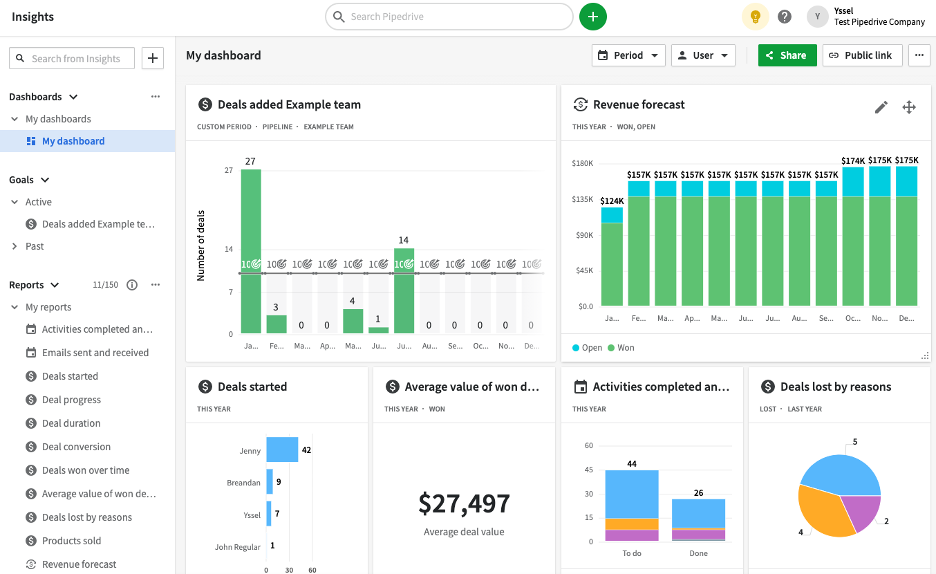Small businesses need user-friendly, capable customer relationship management (CRM) systems to help manage customer relationships, nurture leads and improve sales. Pipedrive and HubSpot are popular CRM solutions with a range of features that can help streamline operations. We’ll compare their essential marketing, lead nurturing, communication and reporting features and more to help your business find the right CRM software for your needs.
Pipedrive and HubSpot are two of the best CRM software solutions around. Here’s an overview of their pricing and offerings.
Criteria
Pipedrive
HubSpot
Starting prices
$14.90 (per user per month, billed annually)
$30 (per month for two users; a free plan is also available)
Free trial for paid plans
Yes (14 days)
Yes (14 days)
Marketing campaigns
Lead nurturing
Omnichannel communications
Reporting and analytics
Integrations and API
Pipedrive is a sales-focused CRM. In fact, the company says it’s a CRM “designed by salespeople for salespeople.” It’s an excellent option for businesses that want to automate sales processes. Sales teams will appreciate Pipedrive’s comprehensive insights, customizable dashboards, deal reports, goal tracking and sales forecasting tools. Marketing teams can use the platform to generate leads. The pricing is competitive; you can add extra functionality to the platform via the 400-plus integrations. To learn more about Pipedrive, read our in-depth Pipedrive review.
HubSpot is a well-rounded CRM with features for sales, marketing and customer service teams. It’s a great choice for businesses that want to optimize sales and marketing outcomes. HubSpot has a great deal of built-in functionality. It’s also easy to customize the platform with time-saving workflow automations for sales funnel management, lead nurturing, after-sales support and more. HubSpot has a free tier and a low-price Starter plan. However, some of its most valuable features reside in higher-priced plans. You can add myriad extra features to HubSpot via 2,000 plug-ins from Pipedrive’s massive app store. Check out our detailed HubSpot CRM review for more information on the platform.
CRM software helps businesses by automating data entry, generating valuable insights, boosting productivity and centralizing data management.
Here’s how HubSpot and Pipedrive compare in essential CRM features and pricing.
HubSpot and Pipedrive have built-in marketing platforms that help you connect with and successfully convert leads.
Pipedrive Marketing Campaign Features
According to Wpromote’s State of B2B Digital Marketing report, email and social media marketing are the most effective B2B marketing tactics for top-of-funnel and bottom-of-funnel campaigns. Ensure your CRM can run both campaign types.
HubSpot Marketing Campaign Features
Winner
HubSpot wins this round. It offers more options and provides deeper insight into campaign data. The platform’s A/B testing, dynamic personalization and segmentation functions are excellent. The unique and helpful dynamic list feature also impressed us. Still, Pipedrive’s marketing platform is very good — better than those of most CRMs we’ve tested.
Pipedrive sells B2B decision-maker data, but the cost per contact is high compared with those of the best list broker services. However, Pipedrive lets you choose the number of records to buy; list brokers often require you to buy thousands.
Here’s how Pipedrive and HubSpot compare for lead nurturing.
Pipedrive Lead Nurturing Features
Pipedrive’s Sales Assistant feature helps reps manage their days, pipelines and workflows. Source: Pipedrive
HubSpot Lead Nurturing Features
HubSpot makes it easy to create and set up custom sales automations. Source: HubSpot
Winner
Pipedrive’s excellent lead nurturing tools give it the edge over HubSpot in this category. These tools are ideal for B2B sales teams that deal with multiple decision-makers, constant changes and multiple stages. However, HubSpot’s lead nurturing tools are sufficient for more straightforward sales.
If your leads aren’t turning into sales, evaluate whether they’re actually ready to buy, ensure you’re following up properly, and examine your sales pitches for effectiveness.
HubSpot and Pipedrive incorporate omnichannel, one-on-one communication very well.
Pipedrive Omnichannel Communications
HubSpot Omnichannel Communications
HubSpot makes it easy for sales and marketing teams to send text messages via the platform. Source: HubSpot
Winner
HubSpot’s built-in email and VoIP functionality win this category. Additionally, HubSpot’s expansive range of apps allows you to communicate with clients on more channels.
CRM reports and data insights are invaluable for small businesses. Here’s how Pipedrive and Hubspot compare.
Pipedrive Reporting and Analytics Features
Add up to 25 widgets to your Pipedrive dashboard to stay abreast of the latest information. Source: Pipedrive
HubSpot Reporting and Analytics Features
Winner
HubSpot wins this category because of its AI-driven analytics, attribution reporting and customer segmentation capabilities. However, Pipedrive’s dashboard customization, deal reports and goal-tracking features are also very helpful.
AI features are becoming more important in CRM adoption decisions as businesses grow to appreciate the detailed insights these tools provide.
Expand the effectiveness of Pipedrive and HubSpot with third-party integrations and APIs.
Pipedrive Integrations
HubSpot Integrations
Only Salesforce CRM has more app integrations than HubSpot. Read our detailed Salesforce CRM review to learn about this platform’s extensive integrations.
Winner
HubSpot is the clear winner for integrations, thanks to its 1,000 apps, data sync plug-ins and an easy-to-navigate app store. However, Pipedrive is catching up; it has over 400 apps, impressive pre-built webhooks and an API developer platform.
HubSpot and Pipedrive offer various service levels. Impressively, HubSpot has a free service for new users.
Pipedrive Pricing
Pricing reflects annually billed costs. If you want to pay monthly, you’ll pay up to 32 percent more.
Plan
Price
Features
Essential
$14.90 per user per month (billed annually)
Advanced
$27.90 per user per month (billed annually)
Includes everything in the Essential plan, plus the following:
Professional
$49.90 per user per month (billed annually)
Includes everything in the Advanced plan, plus the following:
Power
$64.90 per user per month (billed annually)
Includes everything in the Professional plan, plus the following:
Enterprise
$99 per user per month (billed annually)
Includes everything in the Power plan, plus the following:
Pipedrive plans cost $14.90 to $99 per user per month. The Professional level ($49.90) delivers the best value with essential sales team features. Higher-level plans offer more flexibility and may suit companies with complex sales processes.
Note that some add-on services will incur additional costs. We were disappointed that Pipedrive doesn’t offer a free subscription, but you can take advantage of a 14-day free trial.
HubSpot Pricing
We were impressed that HubSpot offers a free service plan with marketing, sales, service, CMS and operations tools. Its paid plans are listed below. Note that the prices reflect monthly charges with an annual commitment. Month-to-month pricing is up to 40 percent more.
Plan
Price
Features
Starter
$30 monthly for two users; $25 for each additional user
Professional
$1,600 for five users; $100 for each additional user; one-time $3,000 onboarding fee
Includes everything in the Starter tier, plus the following:
Enterprise
From $5,000 monthly for 10 users
Includes everything in the Professional package, plus 10,000 marketing contacts and additional tools
HubSpot’s free tier is a rarity in the market and comes with a respectable feature set. The Starter package is also a good value, with features such as email retargeting and sales automation. The Professional level brings a significant cost leap and a one-time $3,000 onboarding fee. You also may need to pay for extra users, API calls and additional charges.
If you want to compare CRMs with free tiers, check out our review of monday CRM; monday is the only other leading CRM provider that currently offers a free service level.
Winner
HubSpot’s platform is more comprehensive; its Starter tier will give many companies the tools they need. However, Pipedrive is also competitively priced, particularly if your company is considering HubSpot’s higher-level tiers.
While HubSpot gives you more features for the money, it’s not suited to all companies. For example, Pipedrive is a better value for businesses with complex B2B sales processes.
Pipedrive and HubSpot have unique target audiences. We recommend both platforms for companies with the following specific needs:
Pipedrive provides central organization for complex sales processes with multiple decision-makers and other challenging factors. It stores and retains information on all prospects and walks reps through each sales process stage. We like that you can buy decision-maker information ad hoc in small volumes, and the platform’s marketing functionality impressed us.
HubSpot is ideal for companies that have more straightforward sales cycles and want their sales and marketing teams to work together. The company’s after-sales support impressed us, making it an excellent choice if your business conducts many post-purchase follow-ups. The free and Starter plans have good functionality. However, the platform’s Professional level shines with omnichannel communications, automation and segmentation tools.
Focus is the primary difference between HubSpot and Pipedrive. HubSpot’s extensive marketing tools are excellent and will support sales, marketing and customer care teams for most products and services. Pipedrive also offers great marketing tools, but it shines because of its excellent support for salespeople with complex products.
Pipedrive is a very effective CRM for companies with sales teams that sell complex, customizable and often expensive products and services, particularly B2B companies. The interface is easy to use, and the workflows are highly customizable to individual sales funnels.
HubSpot is a market-leading CRM, but it might not be the right fit for your company. For example, Salesforce and Oracle NetSuite provide more enterprise-level capabilities for large, complex businesses. HubSpot is easy to use, but Freshworks and Zoho, although not as full-featured as HubSpot, may be more user-friendly. Choosing the right CRM for your business is difficult; your decision should be guided by price, ease of use and the ability to be customized to your company’s specific needs and priorities.
B. newsletter is your digest of bite-sized news, thought & brand leadership, and entertainment. All in one email.
Our mission is to help you take your team, your business and your career to the next level. Whether you're here for product recommendations, research or career advice, we're happy you're here!
Pipedrive vs HubSpot Comparison for 2023 – Business.com

